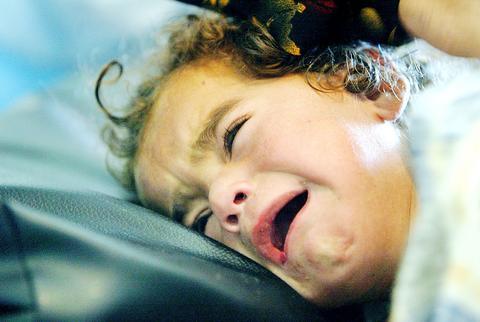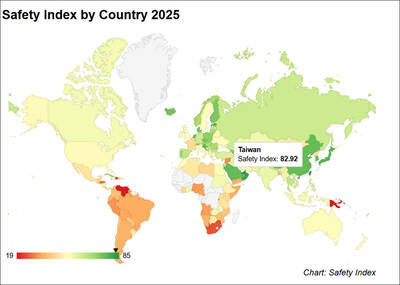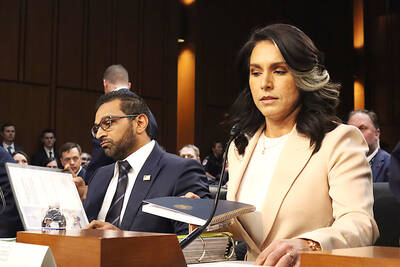The bride arrives in a white pickup truck and is quickly ushered into a house by a group of women. Outside, men recline on brightly colored silk pillows, relaxing on the carpeted floor of a large goat-hair tent as boys dance to tribal songs.
The videotape obtained Sunday by Associated Press Television News (APTN) captures a wedding party that survivors say was later attacked by US planes early Wednesday, killing up to 45 people. The dead included the cameraman, Yasser Shawkat Abdullah, hired to record the festivities, which ended Tuesday night before the planes struck.

PHOTO: AP
The US military says it is investigating the attack, which took place in the village of Mogr el-Deeb about 8km from the Syrian border, but that all evidence so far indicates the target was a safe house for foreign fighters.
"There was no evidence of a wedding: no decorations, no musical instruments found, no large quantities of food or leftover servings one would expect from a wedding celebration," Brigadier-General Mark Kimmitt, the chief US military spokesman in Iraq, said on Saturday. "There may have been some kind of celebration. Bad people have celebrations, too."
But video that APTN shot a day after the attack shows fragments of musical instruments, pots and pans, and brightly colored beddings used for celebrations, scattered around the bombed out tent.
The wedding videotape shows a dozen white pickup trucks speeding through the desert escorting the bridal car -- decorated with colorful ribbons. The bride wears a Western-style white bridal dress and veil. The camera captures her stepping out of the car but does not show a close-up.
A reporter and photographer, who interviewed more than a dozen survivors a day after the bombing, were able to identify many of them on the wedding party video -- which runs for several hours.
APTN also traveled to Mogr el-Deeb, 400km west of Ramadi, the day after the attack to film what the survivors said was the wedding site. A devastated building and remnants of the tent, pots and pans could be seen, along with bits of what appeared to be the remnants of ordnance, one of which bore the marking "ATU-35," similar to those on US bombs.
A water tanker truck can be seen in both the video shot by APTN and the wedding tape obtained from a cousin of the groom.
The singing and dancing seems to go on forever at the all-male tent set up in the garden of the host, Rikad Nayef, for the wedding of his son, Azhad, and the bride, Rutbah Sabah. The men later move to the porch when darkness falls, apparently taking advantage of the cool night weather. Children, mainly boys, sit on their fathers' laps; men smoke an Arab water pipe, finger worry beads and chat with one another. It looks like a typical, gender-segregated tribal desert wedding.
As expected, women are out of sight -- but according to survivors, they danced to the music of Hussein al-Ali, a popular Baghdad wedding singer hired for the festivities. Al-Ali was buried in Baghdad on Thursday.
Prominently displayed on the video-tape was a stocky man with close-cropped hair playing an electric organ. Another tape, filmed a day later in Ramadi, showed the musician lying dead in a burial shroud -- his face clearly visible and wearing the same tan shirt as he wore when he performed.
As the musicians played, young men milled about, most dressed in traditional white robes. Young men swayed in tribal dances to the monotonous tones of traditional Arab music. Two children -- a boy and a girl -- held hands, dancing and smiling. Women are rarely filmed at such occasions, and they appear only in distant glimpses.
Kimmitt said US troops who swept through the area found rifles, machine guns, foreign passports, bedding, syringes and other items that suggested the site was used by foreigners infiltrating from Syria.
The video showed no weapons, though they are common among rural Iraqis.
Kimmitt has denied finding evidence that any children died in the raid although a "handful of women" -- perhaps four to six -- were "caught up in the engagement."
"They may have died from some of the fire that came from the aircraft," he said on Friday.
However, an AP reporter obtained names of at least 10 children who relatives said had died. Bodies of five of them were filmed when survivors took them to Ramadi for burial on Wednesday. Iraqi officials said at least 13 children were killed.
Four days after the attack, the memories of the survivors remain painful -- as are their injuries.
"At about 3am, we were sleeping and the planes started firing," said one of the mourners, who gave his name only as Bassem. "They fired more than 40 missiles. As soon as they started attacking, firing the first missile, I went away. I was running. ... There are no fighters. These are lies. There's no resistance. Even the bride and the groom died."
Haleema Shihab, 32, one of the three wives of Rikad Nayef, said that as the first bombs fell, she grabbed her seven-month-old son, Yousef, and clutching the hands of her five-year-old son, Hamza, started running. Her 15-year-old son Ali sprinted alongside her. They managed to run for several meters when she fell -- her leg fractured.
"Hamza was yelling, `Mommy,'" Shihab recalled. "Ali said he was hurt and that he was bleeding. That's the last time I heard him." Then another shell fell and injured Shihab's left arm.
"Hamza fell from my hand and was gone. Only Yousef stayed in my arms. Ali had been hit and was killed. I couldn't go back," she said from her hospital bed in Ramadi.
She and her stepdaughter, Iqbal then hid in a bomb crater. "We were bleeding from 3am until sunrise," Shihab said.
Shihab's stepdaughter, 14-year-old Moza, lies on another bed of the hospital room. She was hurt in the leg and cries. Her relatives haven't told her yet that her mother, Sumaya, is dead.
Her sister, Iqbal, lay in pain on the bed next to her. Her other sister, Subha, was on the upper floor of the hospital.

AIR SUPPORT: The Ministry of National Defense thanked the US for the delivery, adding that it was an indicator of the White House’s commitment to the Taiwan Relations Act Deputy Minister of National Defense Po Horng-huei (柏鴻輝) and Representative to the US Alexander Yui on Friday attended a delivery ceremony for the first of Taiwan’s long-awaited 66 F-16C/D Block 70 jets at a Lockheed Martin Corp factory in Greenville, South Carolina. “We are so proud to be the global home of the F-16 and to support Taiwan’s air defense capabilities,” US Representative William Timmons wrote on X, alongside a photograph of Taiwanese and US officials at the event. The F-16C/D Block 70 jets Taiwan ordered have the same capabilities as aircraft that had been upgraded to F-16Vs. The batch of Lockheed Martin

GRIDLOCK: The National Fire Agency’s Special Search and Rescue team is on standby to travel to the countries to help out with the rescue effort A powerful earthquake rocked Myanmar and neighboring Thailand yesterday, killing at least three people in Bangkok and burying dozens when a high-rise building under construction collapsed. Footage shared on social media from Myanmar’s second-largest city showed widespread destruction, raising fears that many were trapped under the rubble or killed. The magnitude 7.7 earthquake, with an epicenter near Mandalay in Myanmar, struck at midday and was followed by a strong magnitude 6.4 aftershock. The extent of death, injury and destruction — especially in Myanmar, which is embroiled in a civil war and where information is tightly controlled at the best of times —

Taiwan was ranked the fourth-safest country in the world with a score of 82.9, trailing only Andorra, the United Arab Emirates and Qatar in Numbeo’s Safety Index by Country report. Taiwan’s score improved by 0.1 points compared with last year’s mid-year report, which had Taiwan fourth with a score of 82.8. However, both scores were lower than in last year’s first review, when Taiwan scored 83.3, and are a long way from when Taiwan was named the second-safest country in the world in 2021, scoring 84.8. Taiwan ranked higher than Singapore in ninth with a score of 77.4 and Japan in 10th with

SECURITY RISK: If there is a conflict between China and Taiwan, ‘there would likely be significant consequences to global economic and security interests,’ it said China remains the top military and cyber threat to the US and continues to make progress on capabilities to seize Taiwan, a report by US intelligence agencies said on Tuesday. The report provides an overview of the “collective insights” of top US intelligence agencies about the security threats to the US posed by foreign nations and criminal organizations. In its Annual Threat Assessment, the agencies divided threats facing the US into two broad categories, “nonstate transnational criminals and terrorists” and “major state actors,” with China, Russia, Iran and North Korea named. Of those countries, “China presents the most comprehensive and robust military threat